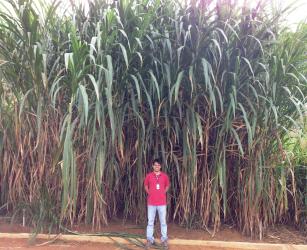Prospecting for genetic variability and performing pre-breeding of napier grass (Pennisetum purpureum Schum.) aiming at the production of energetic biomass
Prospecting for genetic variability and performing pre-breeding of napier grass (Pennisetum purpureum Schum.) aiming at the production of energetic biomass

Photo: MACHADO, Juarez Campolina
The growing demand for a sustainable energy matrix and the need to reduce dependence on fossil fuels make the energy obtained from biomass a prominent option. The major uses of biomass as energetic input are the production of thermal energy (direct combustion, charcoal and residues), production of mechanic energy (alcohol and bio-oils), production of electricity (through combustion, gasification or gas burning), and production of other components of the so called green chemistry (bioproducts and metabolites of industrial interest). For all mentioned cases, napier grass is regarded as a potentially sustainable alternative, given its high photosynthetic efficiency and expressive dry matter accumulation and biological nitrogen fixation, besides desirable chemical properties. In spite of the use of napier grass as a biomass source for energy production, there is still a need for developing specific genotypes for such a purpose exhibiting characteristics diverse than those traditionally chosen for animal feeding. This project aims at prospecting for genetic variability and evaluating the napier grass germplasm collection regarding the characteristics of interest for the production of bioenergy, and performing pre-breeding enhancement of genetic materials for developing pre-technological products with the focus on energetic use. The expected results are added value innovation assets for characteristics of interest for bioenergy production. Products expected at the end of the project are synthetic populations (to be obtained by intercrossing the best genotypes), desired alleles incorporated into elite genotypes, and the identification of outstanding accessions for bioenergy production. The obtainment of these products will favor the utilization of napier grass as an alternative energy source, thus contributing for reducing deforestation and emission of CO2 and enhancing the competitiveness of Brazil in the bioenergy sector.
Ecosystem: Coastal Areas, Extreme South, Atlantic Forest, Semi-mixed and seasonal forests, Mid-North, Cerrados Region, Ecological Transition
Status: Completed Start date: Sun Jun 01 00:00:00 GMT-03:00 2014 Conclusion date: Fri May 31 00:00:00 GMT-03:00 2019
Head Unit: Embrapa Dairy Cattle
Project leader: Juarez Campolina Machado
Contact: juarez.machado@embrapa.br
Keywords: Recursos genéticos, bioenergia, banco de germoplasma
